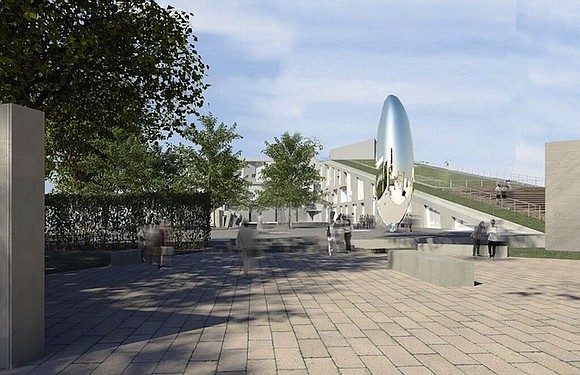First Phase of MFAH Campus Transformation Opens in May 2018
Style Magazine Newswire | 11/14/2017, 9:35 a.m.

HOUSTON—November 14, 2017—The Museum of Fine Arts, Houston, today announced that in May 2018, the first phase of the Museum’s campus transformation will be inaugurated, with the completion of the new Glassell School of Art building, by Steven Holl Architects; the school’s BBVA Compass Roof Garden; and the adjacent Brown Foundation, Inc. Plaza, by Deborah Nevins & Associates.
The school, roof garden, and plaza are the first major features of the newly redesigned Susan and Fayez S. Sarofim Campus to open. Originally slated for January 2018, the school and plaza were delayed until May as a result of flooding during Hurricane Harvey. The entire 14-acre transformation—which also includes the Nancy and Rich Kinder Building for modern and contemporary art, by Steven Holl Architects; the Sarah Campbell Blaffer Foundation Center for Conservation, by Lake|Flato Architects; and a landscape plan with multiple public plazas, by Deborah Nevins & Associates—will open in early 2020. The Sarofim Campus project will expand the role the Museum plays in the daily life of Houston, not only as a cultural institution but also as an urban oasis that is open to all, invigorating the surrounding area. In addition to the new pedestrian walkways that will unite the campus, two new pedestrian tunnels will allow for all of the Museum’s gallery buildings to be linked underground.
“It is fitting that the public’s first experience of the Museum’s transformed campus will be a new public plaza and Glassell School of Art, given that the Museum itself was founded as a kind of art school without walls, in 1900,” said Gary Tinterow, director of the MFAH. “With the school’s walkable rooftop terrace and amphitheater, and the plaza’s generous outdoor spaces—including the magnificent new Anish Kapoor Cloud Column and our iconic 1966 Eduardo Chillida sculpture, Song of Strength—the plaza and the school will be the public gateway to the entire Sarofim Campus.”
“With fundraising now past 86 percent of our $450-million goal for construction and endowment, the completion of the Glassell School of Art and Brown Foundation, Inc. Plaza gives the public a preview of the transformed campus that will be fully completed in early 2020,” said Richard D. Kinder, chairman of the MFAH. “With the school’s and the plaza’s opening, we will already start to see the project’s extraordinary benefits to the Houston community being realized.”
Seamless Integration of Architecture and Public Space
Steven Holl Architects has designed a bold, L-shaped building for the Glassell School of Art. Constructed from monumental precast concrete panels and alternating panes of glass, each unique in shape and size, the building’s hinged form presents a visual pattern on all facades. Inside, a broad-stepped central staircase provides a gathering place, and several public-exhibition spaces allow for the informal display of art. Three dozen studio spaces, all illuminated with natural light, are designed to serve the school’s student mix of children and adults. In addition, the 80,000-square-foot building will house a satellite of the Museum’s MFA Café and a 75-seat auditorium. Below ground, a soaring arrival hall for schoolchildren, and offices for the Museum’s Learning and Interpretation staff, will be adjacent to the 285-car parking garage. Outside, in back of the building, a sheltered courtyard will provide outdoor space for welding and fabricating sculpture, and for firing ceramics.
“Our building for the Glassell School of Art is a key part of the overall strategy to shape the public spaces for the entire campus,” said Steven Holl. “The alternating concrete and glass panels create a porosity between indoors and out, and the gathering spaces, including the building’s walkable, sloping roof, provide a civic experience for students and the public alike, with a spectacular view of the neighborhood and city skyline.”
The school’s structure establishes a seamless flow between its interior and the outdoor spaces designed by Deborah Nevins & Associates, with Nevins Benito Landscape Architects. The school’s roofline, itself a public walkway, connects two prominent gathering places: the roof terrace atop the three-level structure, with dramatic views of the campus and the city, and amphitheater-style seating at the base. The roofline will be planted with jasmine ground cover throughout, and grasses at top. A concrete walkway will run the length of it, from the base at the plaza, to the terrace. The roofline will also be accessible by elevator. The roofline, the plaza, and eventually the completed campus will be universally accessible.
In front of the Glassell School building, the expansive new Brown Foundation, Inc. Plaza will front onto Montrose Boulevard to the west, establishing a public gateway to the school and eventually the entire 14-acre campus, and onto Isamu Noguchi’s 1986 Cullen Sculpture Garden to the south, allowing for passage between the two. Elevated a few steps up from street level, the plaza will have moveable seating, a grove of shade trees, and a water feature that can be a shallow reflecting pool or activated splash fountain, with rising jets that both animate and cool the space. Defined by the L shape of the Steven Holl building, the 36,000-square-foot plaza will provide ample space for everyday public use, as well as for programs and events.
“With the new plaza and the school’s walkable roof, the public can experience the architects’ vision for unifying the Museum’s many components and creating a universally accessible MFAH campus,” said Deborah Nevins. “Whether they arrive at the new Brown Foundation, Inc. Plaza from the sidewalk along Montrose Boulevard, or from Noguchi’s sublime sculpture garden, visitors will be able to move freely among the distinct spaces we have created on the plaza: from the seating under shade trees and the reflecting pool; to the garden-level amphitheater; up the walkway of the sloped roof to the planted and sheltered terrace that overlooks the Museum campus and the city to the south.”
The new Glassell building is twice the size of the previous building, reflecting the growth over nearly 40 years in the popularity of the school’s renowned program, which is unique among the nation’s art museums for serving students from preschool to postgraduate. The school’s summer youth classes begin at the new building in June, and fall-semester adult classes start in August.
Two Public Sculptures for the 36,000-Square-Foot Plaza
wo major public sculptures will be sited on the Brown Foundation, Inc. Plaza: the newly acquired Cloud Column (2006) by Anish Kapoor, and Eduardo Chillida’s iconic Song of Strength (1966), which will be relocated from its longtime site in front of the Museum’s original 1924 entrance. “These two monumental sculptures by artists of different generations will anchor the plaza at either side, each animated by the play of light and shadow but in very different ways,” Tinterow said. “Song of Strength, with its stacked granite plinths, will echo the sturdy geometry of the Glassell School’s facade as well as the interplay of concrete and glass. Across the way, Cloud Column’s polished-steel surface will activate the plaza with the ever-changing reflections of its surroundings.”
Redevelopment Overview: The Susan and Fayez S. Sarofim Campus
Encompassing 14 acres in the heart of Houston’s Museum District, the Susan and Fayez S. Sarofim Campus will be a major contribution to the city’s efforts to improve the pedestrian experience of Houston. With its generous array of public plazas, reflecting pools, and gardens, as well as improved sidewalks, street lighting, and way finding, the campus will provide an active setting for a century’s worth of architecturally significant buildings and three new structures: the Glassell School of Art and the Nancy and Rich Kinder Building (Steven Holl Architects, May 2018 and early 2020), and the Sarah Campbell Blaffer Foundation Center for Conservation (Lake|Flato Architects, 2018). The campus transformation is projected to have a major impact on the city: in the near term through job creation, and in the long term by generating nearly $334 million in economic activity over 20 years, with more than $2.5 million in direct, indirect, and induced city tax revenues.






